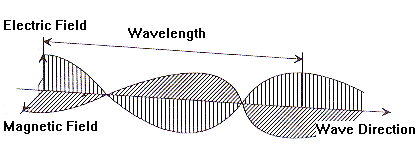 |
 |
 Electromagnetic Radiation
Electromagnetic Radiation
Electromagnetic Waves
Electromagnetic waves are energy transported through space in the form of periodic disturbances of electric and magnetic fields. All electromagnetic waves travel through space at the same speed, c = 2.99792458 x 108 m/s, commonly known as the speed of light. An electromagnetic wave is characterized by a frequency and a wavelength. These two quantities are related to the speed of light by the equation,
The frequency (and hence, the wavelength) of an electromagnetic wave depends on its source. There is a wide range of frequency encountered in our physical world, ranging from the low frequency of the electric waves generated by the power transmission lines to the very high frequency of the gamma rays originating from the atomic nuclei. This wide frequency range of electromagnetic waves constitute the Electromagnetic Spectrum. The Electromagnetic Spectrum
The electromagnetic spectrum can be divided into several wavelength (frequency) regions, among which only a narrow band from about 400 to 700 nm is visible to the human eyes. Note that there is no sharp boundary between these regions. The boundaries shown in the above figures are approximate and there are overlaps between two adjacent regions.
PhotonsAccording to quantum physics, the energy of an electromagnetic wave is quantized, i.e. it can only exist in discrete amount. The basic unit of energy for an electromagnetic wave is called a photon. The energy E of a photon is proportional to the wave frequency f,
where the constant of proportionality h is the Planck's Constant,

 Atmospheric Effects Atmospheric Effects
 Go to Main Index Go to Main Index
|